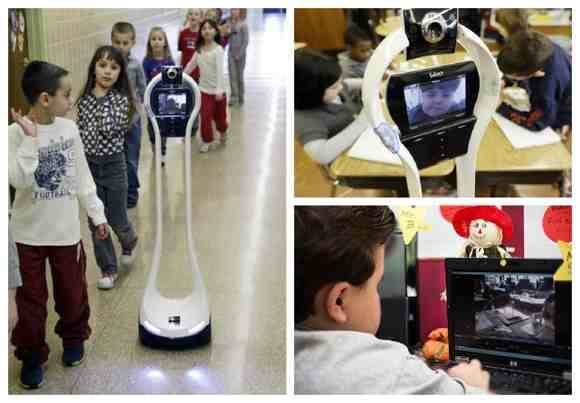
VGo is a telepresence robot developed by Nashua, NH-based VGo Communcations. Since January 2012 it has enabled Devon to attend Winchester Elementary School in West Seneca, NY. He communicates wirelessly with the robot from his home five miles away, navigating it down hallways and into classrooms.
At school Devon has the job of “greeter” where he greets fellow classmates at the school’s entrance in the morning. He speaks through VGo speakers, and the teacher speaks through a microphone and amplifier so that Devon can easily hear her. And when he needs to raise his hand a light on the robot is activated. VGo can run for an entire school day without needing to be recharged – more than can be said for some students I’m sure.
As Winchester Principal Kathleen Brachmann explains, it’s a world of difference between sitting at home alone with your books and being able to participate in classroom discussion or join your friends in the hallway for lockerside chats. “Walking down a hallway, seeing other kids,” she told the Washington Post, “you couldn’t expose somebody on a Skype session that way. It would just be like a TV screen. With this he really gets a feel, a sensation, of being there.”
Of course, getting around with VGo does have its extra work. Before it takes off down a hall, the Segway-looking robot lowers its camera to make sure the area in front of it is clear of objects and small people. It can sense large objects in its path and knows when it comes to a set of stairs. That’s when Devon has to wait for a teacher to lift his VGo. Luckily, the robot only weighs 18 pounds. But robots aren’t cheap. Generously, the school district is covering the $6,000 cost for VGo and the $100 per month service fees.

Already VGos are being used by kids in New Jersey, Iowa, Wisconsin and Texas to send their personal “avatars” to school while staying safely away due to health reasons. If the rapidly growing number of telepresence robots joining the market is any indication, the number of children telecommuting through robots is likely to increase in the near future. Not to be confined to the classroom, physicians are also already using telepresence robots to be in two places at once and check up on patients that are miles away.
As yet, costs are too high right now for the robots to become a widespread solution, but no doubt more mobile avatars will be scooting down school hallways and hospitals in the future as costs go down. It’s possible that at some point even perfectly healthy and able students may be given the choice to telecommute just because they want to, or they’ll use the robots to participate in some overseas exchange program. As the students who’ve already had their lives enriched by the robots I’m sure feel, the sky’s the limit.



